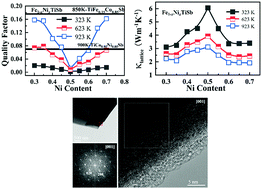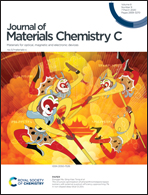Realizing both n- and p-types of high thermoelectric performance in Fe1−xNixTiSb half-Heusler compounds†
Abstract
Achieving high thermoelectric performance in the same compounds with close composition is crucial for practical applications. Hereby, Fe1−xNixTiSb samples are synthesized by arc melting, ball milling and hot pressing, which exhibit both n- and p-type conducting behavior depending on the Fe/Ni ratio. The random distribution of Fe/Ni on the 4c sublattice, which is closely related to low lattice thermal conductivity, is determined by transmission electron microscopy. In addition, the optimum ball milling time, which varies with different compositions, is determined by transport coefficient analysis. Moreover, the thermoelectric transport properties of Fe1−xNixTiSb samples are investigated in detail and the results indicate that Fe/Ni substitution leads to an increase in the density of states effective masses and reduction in lattice thermal conductivity. As a result, a dimensionless figure of merit of 0.48 is obtained for p-type Fe0.65Ni0.35TiSb and 0.40 for n-type Fe0.3Ni0.7TiSb at 923 K, which is comparable to that of CoTiSb but without expensive elements. Our results will motivate continuous efforts in searching for new half-Heusler compounds having high thermoelectric performance in both n- and p-types with close compositions.



 Please wait while we load your content...
Please wait while we load your content...